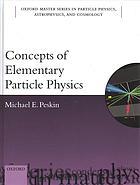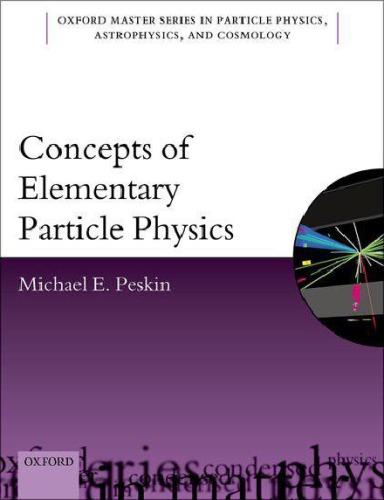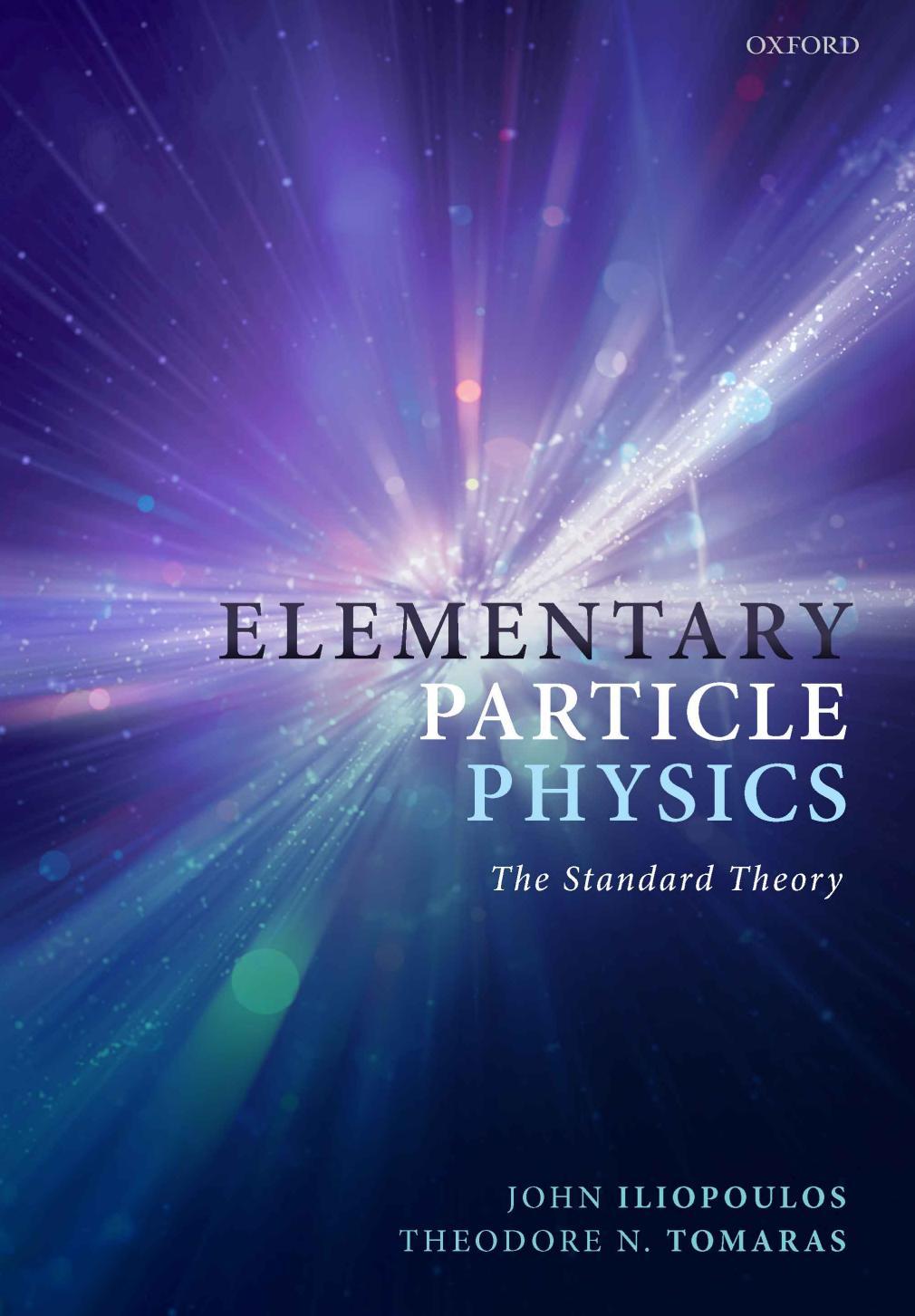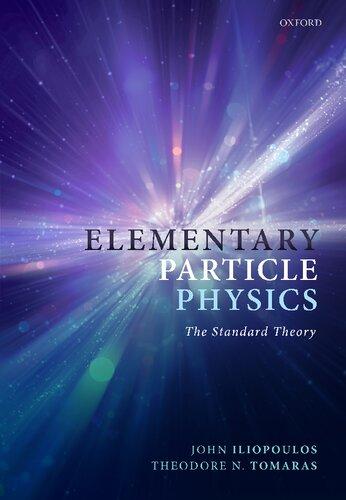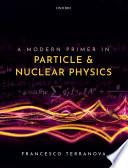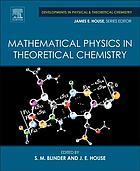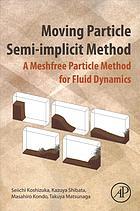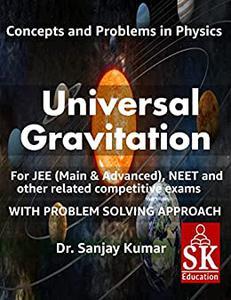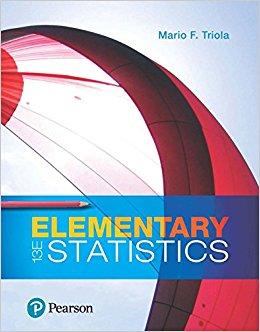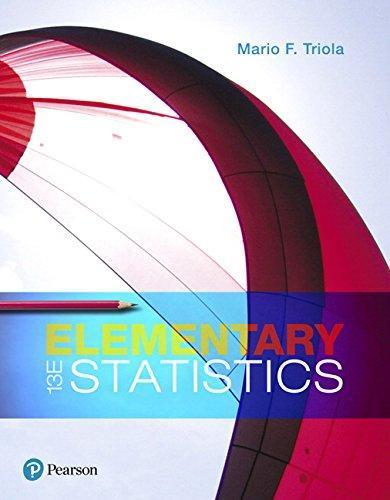Conceptsof ElementaryParticlePhysics
MichaelE.Peskin SLAC,StanfordUniversity
(versionofDecember4,2017)
Preface
Thisisatextbookofelementaryparticlephysics,intendedforstudents whohaveasecureknowledgeofspecialrelativityandhavecompleted anundergraduatecourseinquantummechanics.
Particlephysicshasnowreachedtheendofamajorstageinitsdevelopment.Theprimaryforcesthatactwithintheatomicnucleus,the strongandweakinteractions,nowhaveafundamentaldescription,with equationsthataresimilarinformtoMaxwell’sequations.Theseforces arethussummarizedinacompactmathematicaldescription,calledthe StandardModelofparticlephysics.ThepurposeofthisbookistoexplainwhattheStandardModelisandhowitsvariousingredientsare requiredbytheresultsofelementaryparticleexperiments.
Increasingly,thereisagapbetweenthestudyofelementaryparticles andotherareasofphysicalscience.Whileotherareasofphysicsseemto applydirectlytomaterialsscience,modernelectronics,andevenbiology, particlephysicsdescribesanincreasinglyremoteregimeofverysmall distances.Physicistsinotherareasareputoffbythesheersizeand expenseofelementaryparticleexperiments,andbytheesoterictermsby whichparticlephysicistsexplainthemselves.Particlephysicsisbound upwithrelativisticquantumfieldtheory,ahighlytechnicalsubject,and thisaddstothedifficultyofunderstandingit.
Still,thereismuchtoappreciateinparticlephysicsifitcanbemade accessible.Particlephysicscontainsideasofgreatbeauty.Itreveals someofthemostdeepandsurprisingideasinphysicsthroughdirect connectionsbetweentheoryandexperimentalresults.Inthistextbook, IattempttopresentparticlephysicsandtheStandardModelinaway thatbringsthekeyideasforward.Ihopethatitwillgivestudentsan entrywayintothissubject,andwillhelpothersgainabetterunderstandingoftheintellectualvalueofourrecentdiscoveries.
Thepresentationofelementaryparticlephysicsinthisbookhasbeen shapedbymanyyearsofdiscussionwithexperimentalandtheoretical physicists.Particlephysicistsformaglobalcommunitythatbringstogethermanydifferentpointsofviewanddifferentnationalstyles.This diversityhasbeenakeysourceofnewideasthathavedriventhefield forward.Ithasalsobeenasourceofintuitivepicturesthatmakeitpossibletovisualizephysicalprocessesinthedistantandabstractdomainof thesubnuclearforces.Ihavetriedtobringasmanyofthesepicturesas possibleintomydiscussionhere.Myownwayofthinkingaboutparticle physicshasbeenshapedbymyconnectionwiththegreatlaboratories atCornellUniversityandSLAC.Iamindebtedtomanycolleaguesat
vi Preface theselaboratoriesforcentralpartsofthedevelopmentgivenhere.
Thecoreofthispresentationwasdevelopedasasetoflecturesfor CERNsummerstudentsin1997;IthankLuisAlvarez-Gaum´eforthe invitationtopresenttheselectures.Ihavepresentedpartsofthismaterialatanumberofsummerschoolsandcourses,inparticular,thecourse onelementaryphysicsatthePerimeterScholarsInternationalprogram atthePerimeterInstitute.Mostrecently,Ihavepolishedthismaterial bymyteachingofthecoursePhysics152/252atStanfordUniversity.I amgratefultoPatriciaBurchatforgivingmethisopportunity,andfor muchadviceonteachingacourseatthislevel.Ithankthestudentsinall ofthesecoursefortheirpatiencewithpreliminaryversionsofthisbook andtheirattentiontoerrorstheycontained.IthankSonkeAdlung, HarrietKonishi,andtheirteamatOxfordUniversityPressfortheir interestinthisproject.IthankTimCohen,ChristopherHill,Andrew Larkoski,AaronPierce,DanielSchroeder,BruceSchumm,andAndr´e DavidTinocoforvaluablecommentsonthepresentation,andJongmin Yoonforanespeciallycarefulreadingofthemanuscript.Mostofall, IthankmycolleaguesintheSLACTheoryGroupfortheiradviceand criticismthathasbenefitedmyunderstandingofelementaryparticle physics.
MichaelE.Peskin Sunnyvale,CA November,2017
IPreliminariesandTools1
1Introduction3
2SymmetriesofSpace-Time7
2.1Relativisticparticlekinematics
2.2Naturalunits
2.3Alittletheoryofdiscretegroups
2.4Alittletheoryofcontinuousgroups
2.5Discretespace-timesymmetries
3RelativisticWaveEquations23
3.1TheKlein-Gordonequation
3.2Fieldsandparticles
3.3Maxwell’sequations
3.4TheDiracequation
3.5Relativisticnormalizationofstates
3.6Spinandstatistics
4TheHydrogenAtomandPositronium39
4.1Theidealhydrogenatom
4.2Finestructureandhyperfinestructure
4.3Positronium
5TheQuarkModel49
5.1Thediscoveryofhadrons
5.2Charmonium
5.3Thelightmesons
5.4Theheavymesons
5.5Thebaryons
6DetectorsofElementaryParticles71
6.1Energylossbyionization
6.2Electromagneticshowers
6.3Furthereffectsofnuclearscattering
6.4Energylossthroughmacroscopicpropertiesofthemedium
7ToolsforCalculation89
IITheStrongInteraction103
8Electron-PositronAnnihilation105
9DeepInelasticElectronScattering121
10TheGluon141
11QuantumChromodynamics161
12PartonsandJets179
12.2Thestructureofjets 183 Exercises 188
13QCDatHadronColliders191
13.1Hadronscatteringatlowmomentumtransfer 191
13.2Hadronscatteringatlargemomentumtransfer 197
13.3Jetstructureobservablesforhadroncollisions 201
13.4Thewidthofajetinhadron-hadroncollisions 203
13.5Productionofthetopquark 205 Exercises 207
14ChiralSymmetry209
14.1SymmetriesofQCDwithzeroquarkmasses 209
14.2Spontaneoussymmetrybreaking 211
14.3Goldstonebosons 215
14.4Propertiesof π mesonsasGoldstonebosons 216 Exercises 220
IIITheWeakInteraction223
15TheCurrent-CurrentModeloftheWeakInteraction225
15.1DevelopmentoftheV Atheoryoftheweakinteraction 226
15.2PredictionsoftheV Atheoryforleptons 227
15.3PredictionsoftheV Atheoryforpiondecay 235
15.4PredictionsoftheV Atheoryforneutrinoscattering 237 Exercises 240
16GaugeTheorieswithSpontaneousSymmetryBreaking243
16.1Fieldequationsforamassivephoton 243
16.2Modelfieldequationswithanon-Abeliangaugesymmetry 245
16.3TheGlashow-Salam-Weinbergelectroweakmodel 247
16.4Theneutralcurrentweakinteraction 251 Exercises 255
17TheWandZBosons257
17.1Propertiesofthe W boson 257
17.2 W productionin pp collisions 260
17.3Propertiesofthe Z boson 262
17.4Precisiontestsoftheelectroweakmodel 263 Exercises 272
18QuarkMixingAnglesandWeakDecays273
18.1TheCabibbomixingangle 273
18.2QuarkmasstermsintheStandardModel 275
18.3Discretespace-timesymmetriesandtheStandardModel 277
18.4TheStandardModelofparticlephysics 279
18.5Quarkmixingincludingheavyquarks 280 Exercises 283
20NeutrinoMassesandMixings303
20.1Neutrinomassand β decay
20.2AddingneutrinomasstotheStandardModel
20.3Measurementsofneutrinoflavormixing
21TheHiggsBoson315
21.1ConstraintsontheHiggsfieldfromtheweakinteraction
21.2ExpectedpropertiesoftheHiggsboson
21.3MeasurementsofHiggsbosonpropertiesattheLHC
DMasterformulaeforthecomputationofcrosssections andpartialwidths345
SymmetriesofSpace-Time 2
Wedonothavecompletefreedominpostulatingnewlawsofnature.Any lawsthatwepostulateshouldbeconsistentwithwell-establishedsymmetriesandinvarianceprinciples.Ondistancescalessmallerthananatom, space-timeisinvariantwithrespecttotranslationsofspaceandtime. Space-timeisalsoinvariantwithrespecttorotationsandboosts,the symmetrytransformationsofspecialrelativity.Manyaspectsofexperimentsonelementaryparticlestesttheprinciplesofenergy-momentum conservation,rotationalinvariance,theconstancyofthespeedoflight, andthespecial-relativityrelationofmass,momentum,andenergy.So far,nodiscrepancyhasbeenseen.Soitmakessensetoapplythesepowerfulconstrantstoanyproposalforelementaryparticleinteractions. Perhapsyouconsiderthisstatementtoostrong.Asweexplorenew realmsinphysics,wemightwelldiscoverthatthebasicprinciplesapplied inmorefamiliarsettingsarenolongervalid.Intheearly20thcentury, realcrisesbroughtonbytheunderstandingofatomsandlightforced physiciststoabandonNewtonianspace-timeinfavorofthatofEinstein andMinkowski,andtoabandontheprinciplesofclassicalmechanicsin favoroftheverydifferenttoolsofquantummechanics.Bysettingrelativityandquantummechanicsasabsoluteprinciplestoberespectedin thesubnuclearworld,wearemakingaconservativechoiceoforientation.Therehavebeenmanysuggestionsofmoreradicalapproachesto formulatinglawsofelementaryparticles.Someofthesehaveevenledto newinsights:The bootstrap ofGeoffreyChew,inwhichthereisnofundamentalHamiltonian,isstillfindingnewapplicationsinquantumfield theory(Simmons-Duffin2017); stringtheory,whichradicallymodifies space-timestructure,isacandidatefortheoverallunificationofparticleinteractionswithquantumgravity(Zwiebach2004,Polchinski2005). However,themostsuccessfulroutestothetheoryofsubnuclearinteractionshavetakentranslationinvariance,specialrelativity,andstandard quantummechanicsasabsolutes.Inthisbook,Iwillmaketheassumptionthatspecialrelativityandquantummechanicsarecorrectinthe realmofelementaryparticleinteractions,andIwillusethetheirprinciplesinastrongwaytoorganizemyexplorationofelementaryparticle forces.
Thisbeingso,itwillbeusefultoformulatetheconstraintsfromspacetimesymmetriesinsuchawaythatwecanapplythemeasily.Wewould liketousetheactualtransformationlawsassociatedwiththesesymmetriesaslittleaspossible.Instead,wewouldliketoformulatequestionsin suchawaythattheanswersareexpressions invariant underspace-time
symmetries.Generally,therewillbeasmallandwell-constrainedsetof possibleinvariants.Ifwearelucky,onlyoneofthesewillbeconsistent withexperiment.
2.1Relativisticparticlekinematics
Asafirststepinsimplifyingtheuseofconstraintsfromspecialrelativity,Iwilldiscussthekinematicsofparticleinteractions.Anyisolatedparticleischaracterizedbyanenergyandavectormomentum.In specialrelativity,theseareunifiedintoa4-vector.Iwillwriteenergymomentum4-vectorsinenergyunitsandnotatethemwithanindex µ =0, 1, 2, 3, Representationoftheenergyandmomentumofaparticlein4-vectornotation.
Iwillnowreviewaspectsoftheformalismofspecialrelativity.Probablyyouhaveseentheseformulaebeforeintermsofrulers,clocks,and movingtrains.Nowwewillneedtousetheminearnest,becauseelementaryparticlecollisionsgenerallyoccuratenergiesatwhichitisessential touserelativisticformulae.
Underaboostby v alongthe 3direction,theenergy-momentum 4-vectortransformsas p → p ,with
Itisconvenienttowritethisasamatrixtransformation
Inthisbook,unlessitisexplicitlyindicatedotherwise,repeatedindicesare summedover.Thisconventionisone ofEinstein’slesser,butstillmuchappreciated,innovations.
Inmultiplyingmatricesandvectorsinthisbook,Iwillusetheconventionthatrepeatedindicesaresummedover.Then,forexample,I willwrite(2.3)as
omittingtheexplicitsummationsignfortheindex ν.Lorentztrans-
formationsleaveinvarianttheMinkowskispacevectorproduct
Tokeeptrackoftheminussigninthisproduct,Iwillmakeuseof raisedandloweredLorentzindices.Lorentztransformationspreserve themetrictensor
2.1 Relativisticparticlekinematics 9
Usingthismatrix,andthesummationconvention,wecanwrite(2.6)as
Alternatively,let q withaloweredindexbedefinedby
Thetheinvariantproductof p and q iswritten
Toformaninvariant,wealwayscombinearaisedindexwithalowered index.Astheequationsinthisbookbecomemorecomplex,wewill findthistrickveryusefulinkeepingtrackoftheMinkowskispaceminus signs.
AparticularlyimportantLorentzinvariantisthesquareofaLorentz vector,
Beinganinvariant,thisquantityisindependentofthestateofmotion oftheparticle.Intherestframe
Iwilldefinethemassofaparticleasitsrest-frameenergy
Since p2 isaninvariant,theexpression
istrueinanyframeofreference.
Inthisbook,Iwillwriteparticlemomentaintwostandardways
where
Especially,thesymbol Ep willalwaysbeusedinthisbooktorepresent thisstandardfunctionofmomentumandmass.Iwillrefertoa4-vector with E = Ep asbeing“onthemassshell”.
Toillustratetheseconventions,Iwillnowworkoutsomesimplebut importantexercisesinrelativistickinematics.Imaginethataparticleof mass M ,atrest,decaystotwolighterparticles,ofmasses m1 and m2.In thesimplestcase,bothparticleshavezeromass: m1 = m2 =0.Then, energy-momentumconservationdictatesthatthetwoparticleenergies
IwilluseraisedandloweredLorentz indicestokeeptrackoftheminus signintheMinkowskivectorproduct.Pleasepayattentiontothepositionofindices—raisedorlowered— throughoutthisbook.
ThemassofaparticleisaLorentzinvariantquantitythatcharacterizes thatparticleinanyreferenceframe.
Definitionsofthequantities Ep, β, γ associatedwithrelativisticparticlemotion.
SymmetriesofSpace-Time
areequal,withthevalue Mc2/2.Then,ifthefinalparticlesmoveinthe ˆ 3direction,wecanwritetheir4-vectorsas
Thenextcase,whichwillappearoftenintheexperimentswewill consider,isthatwith m1 nonzerobut m2 =0.Intherestframeof Thesekinematicformulaewillbeused veryofteninthisbook. theoriginalparticle,themomentaofthetwofinalparticleswillbeequal andopposite.Withalittlealgebra,onecandetermine
(formotioninthe 3direction),where
Itisalsoeasytocheckthattheseformulaestatisfytheconstraintsof totalenergy-momentumconservationandthemass-shellconstraintthat p1 satisfies(2.14).
Finally,wemightconsiderthegeneralcaseofnonzero
and m2 Here,ittakesalittlemorealgebratoarriveatthefinalformulae
with
wherethekinematic λ functionisdefinedby
Thesethreesetsofformulaeapplyequallywelltoreactionswithtwo particlesintheinitialstateandtwoparticlesinthefinalstate.Itis onlynecessarytoreplace Mc2 withthecenterofmassenergy ECM of thereaction.
2.2Naturalunits
Inthediscussionofthepreviouschapter,Ineededtointroducemany factorsof c inordertomakethetreatmentofenergy,momentum,and massmoreuniform.Thisisafactoflifeinthedescriptionofhigh energyparticles.Ideally,weshouldtakeadvantageoftheworldviewof relativitytopassseamlesslyamongtheseconcepts.Equallywell,our discussionsofparticledynamicswilltakeplaceinaregimeinwhich quantummechanicsplaysanessentialrole.Tomakethebestuseof
quantumconcepts,weshouldbeabletopasseasilybetweentheconcepts ofmomentumandwavenumber,orenergyandfrequency.
Tomakethesetransitionsmosteasily,Iwill,inthisbook,adopt naturalunits,
h = c =1 (2.24)
Thatis,Iwillmeasuremomentumandmassinenergyunits,andIwill measuredistancesandtimesininverseunitsofenergy.Forconvenience indiscussingelementaryparticlephysics,IwilltypicallyusetheenergyunitsMeVorGeV.Thiswilleliminateagreatdealofunnecessary baggagethatwewouldotherwiseneedtocarryaroundinourformulae.
Forexample,towritethemassoftheelectron,Iwillwrite not me =0.91 × 10 27gbutrather me =0.51MeV . (2.25)
Anelectronwithamomentumoftheorderofitsrestenergyhas,accordingtotheHeisenberguncertaintyprinciple,apositionuncertainty h mec =3 9 × 10 11 cm , (2.26)
whichIwillequallywellwriteas
Naturalunitsmakeitveryintuitivetoestimateenergies,lengths,and timesintheregimeofelementaryparticlephysics.Forexample,the
Naturalunitsareusefulforestimation. lighteststronglyinteractingparticle,the π meson,hasamass
Thiscorrespondstoadistance
mπc =1 4 × 10 13 cm
andatime h
Thesegive—withinafactor2orso—thesizeoftheprotonandthe lifetimesoftypicalunstablehadrons.So,theuseof mπ givesagood firstestimateofalldimensionfulstronginteractionquantities.Toobtain anestimateinthedesiredunits—MeV,cm,sec—wewoulddecorate thesimpleexpression mπ withappropriatefactorsof¯h and c andthen evaluateasabove.
Itmaymakeyouuncomfortableatfirsttodiscardfactorsof¯h and c Getusedtoit.Thatwillmakeitmucheasierforyoutoperformcalcu-
Thematerialinthisbookwillbeeasier tograspifyoumakeyourselfcomfortablewiththeuseofnaturalunits.This willbothsimplifyformulaeandsimplify manyestimatesofenergies,distances, andtimes. lationsofthesortthatwewilldointhisbook.Someusefulconversion factorsformovingbetweendistance,time,andenergyunitsaregivenin AppendixB.
SymmetriesofSpace-Time
Theintrinsicstrengthsofthebasicelementaryparticleinteractionsarenot apparentfromthesizeoftheireffect— orfromtheirnames.Hereisapreview.
Oneinterestingquantitytoputintonaturalunitsisthestrengthof theelectricchargeoftheelectronorproton.TheCoulombpotentialis giveninstandardnotationby
Grouptheoryplaysanimportantrole inelementaryparticlephysics.Especiallyifyouareuncomfortablewith mathematicalabstraction,pleaseread Sections2.3and2.4carefully.You havealreadymadeuseofgrouptheory inyourstudyofquantummechanics. Inthissections,Iintroduceterminologythatwillallowyoutoextendthis understandingtotheapplicationsdiscussedinthisbook.
Iwilluseunitsforelectromagnetisminwhichalso
ThentheCoulombpotentialreads
Since r,innaturalunits,hasthedimensionsof(energy) 1,thevalue oftheelectricchargemusthaveanforminwhichitisdimensionless. Indeed,
isadimensionlessnumber,calledthe finestructureconstant,withthe value
Therearetworemarkablethingsaboutthisequation.First,itissurprisingthatthereisadimensionlessnumber α thatcharacterizesthe strengthoftheelectromagneticinteraction.Second,thatnumberis small,signallingthattheelectromagneticinteractionisaweakinteraction.Oneofourgoalswillbetodeterminewhetherthestrongand
weaksubnuclearinteractionscanbecharacterizedinthesameway,and whethertheseinteractions—lookingbeyondtheirnames—areintrinsicallystrongorweak.Iwilldiscussestimatesofthestrongandweak interactioncouplingstrengthsatappropriatepointsinthecourse.It willturnoutthatthestronginteractionisweak,atleastwhenmeasuredunderthecorrectconditions.Itwillalsoturnoutthattheweak interactionisalsoweakindimensionlessterms.Itisweakerthanthe stronginteractions,butnotasweakaselectromagnetism.
2.3Alittletheoryofdiscretegroups
Grouptheoryisaveryimportanttoolforelementaryparticlephysics.
Inthissectionandthenext,Iwillreviewhowgrouptheoryisusedin quantummechanics,andIwilldiscusssomepropertiesofgroupthat wewillmeetinthisbook.Forthemostpart,thesesectionswillreview materialthatyouhaveseeninyourquantummechanicscourse.But, becausetherewillbemanyappealstogrouptheoryconceptsinthis book,itwillbebesttoputtheseconceptsclearlyinorder.Forthis reason,thesetwosectionswillberatherpreciseandformal.Thislevel ofprecisionwillpayoffasweusetheseideasinmanyexamples.
2.3 Alittletheoryofdiscretegroups 13
Inquantummechanics,wedealwithgroupsontwolevels.First, thereareabstractgroups.Inmathematics,a group isasetofelements G = {a,b,...} withamultiplicationlawdefined,sothat ab isdefinedand isanelementof G.Themultiplicationlawsatisfiesthethreeproperties Herearetheaxiomsthatdefinea group.
(1) Multiplicationisassociative: a(bc)=(ab)c
(2) G containsan identityelement 1suchthat,foranyelementof G, 1a = a1= a
(3) Foreach a in G,thereisanotherelement a 1 suchthat aa 1 = a 1a =1.
Everysymmetriesofnaturenormallyencounteredinphysicssatisies theseaxiomsandisdescribedbyanabstractgroup.
interestedinisdescribedbyaHamiltonian H whoseeigenvaluesgive theenergylevels.Asymmetryoftheproblemisimplementedbya unitarytransformation U.If[U ,H]=0,stateslinkedby U havethe sameenergy.
Inquantummechanics,thebasicelementsarevectors(or,quantum states)inaHilbertspace.Symmetriesconvertoneofthesestatesto anotherbyaunitarytransformation.Thephysicsproblemweare TheactionofagroupontheHilbert spaceofstatesinquantummechanicsis describedthroughunitaryrepresentationsofthegroup.Thus,unitarygroup representationswillbeusedinmanyaspectsofthephysicsdiscussedinthis book.
Todescribetheactionofagroup G inquantummechanics,weassociatewith G a representation ofthegroupintermsofunitarymatrices thatactonthisHilbertspace.Aunitaryrepresentation GR of G isa setofmatrices {Ua} suchthat,if ab = c,then UaUb = Uc bymatrix multiplication.Theabstractgroupelement1isrepresentedbytheunitarymatrix U =1.The Ua mightbematricessuchas U abovethatact onthewholeHilbertspace.Moreoften,though,weworkwithfinitedimensionalmatricesthatactonasubspaceofthefullHilbertspace.
Symmetriesthatinvolvetransformationsofspace-timecoordinates, suchasthespecialrelativitytransformationsdiscussedinSection2.1, arecalled space-timesymmetries.Wewillencounterothersymmetry transformationsthatdonotinvolvespace-time.Thesearecalled internal symmetries
Forexample,therearetwoparticles π+ and π thathaveequalmasses andequallifetimes.Wemightpostulateasymmetryoperationcalled C thattransforms
Theactionof C onthis2-dimensionalsubspaceisrepresentedbythe matrix
If[C,H]=0,thatwouldimplythatthemassesanddecayratesof π+ and π mustbeequal.OnthesameHilbertspace,wecandefinethe trivialoperation
SymmetriesofSpace-Time
Thisisrepresentedby
Thereisasimplediscretegroup Z2 withelements {1, ( 1)} andthe multiplicationlaw
Thematrices(2.39)and(2.37)formaunitaryrepresentationofthis abstractgroup,with(2.39)representing1and(2.37)representing( 1). Thisrepresentationactsasaninternalsymmetryonthetheoryof π+ and π .Itisaninterestingquestion,takenupinSection2.5,whether thissymmetrycanbeextendedtoanexactsymmetryofallofparticle physics.
Agroup G iscalled Abelian if,forall a, b in G, ab = ba.Otherwise,itis non-Abelian.AunitarityrepresentationofanAbeliangroup G consists ofunitarymatricesthatcommutewithoneanother.Thismeansthat theycanbesimultaneouslydiagonalized.Theoperationofthegroupis thenreducedtosimplenumbers.Intheexampleabove,thematrices AnAbeliangroupisdescribedbyits eigenstatesandtheireigenvalues.The eigenvaluesarepreciselywhatphysicistscallthe quantumnumbers ofa state.
Theconceptofan irreducible group representation.Manyphysicsproblems inquantummechanicsaresolvedby breakingupalargerHilbertspaceinto irreduciblerepresentationsofanappropriatesymmetrygroup.
(2.39)and(2.37)arediagonalizedinacommonbasis,andweuse C to refertotheeigenvalueofthematrixrepresenting C,
Because C 2 =1,operationtwicewiththematrix C mustgivebackthe originalstate: C C |ψ = |ψ .Thismust,inparticular,betrueforan eigenstate,sotheeigenvaluesof C canonlybe ±1.Itisconventionalto use C alsoasasymbolfortheeigenvalueof C ononeofitseigenstates. Thoughinthisusage, C isapurenumber,wedosaythatthefirststate in(2.41)has C =+1andthesecondhas C = 1.
Ifthegroup G isnon-Abelian,and GR isaunitaryrepresentationof G,itisgenerallynotpossibletosimultaneouslydiagonalizeallofthe unitarymatricesin GR.However,byachangeofbasis,wecanreduce thesematricestoacommonblock-diagonalform
wheretheblocks U1,U2,U3, areassmallaspossible.Theseminimal-
sizeunitarytransformationsrepresenting G arecalled irreducibleunitary representationsof G.Foranirreduciblerepresentation {Ui},thesizeof thematricesiscalledthe dimension di oftherepresentation.Thenotion ofirreduciblerepresentationsisprobablymorefamiliartoyouinthe contextofcontinuousgroups.Iwillputyourknowledgeoftherotation groupintothiscontextinthenextsection.
Itisastandardproblemingrouptheorytoworkoutthesetofirreduciblerepresentationsthatareinequivalentbyunitarytransformations.
Itcanbeprovedthat,foradiscretegroup G with n elements,theinequivalentunitarytransformationssatisfy
d2 i = n. (2.43)
AnexampleisgivenbythegroupofΠ3 ofpermutationsonthree elements.Wecanrepresentsuchapermutationastheresultoftransformingthesetoflabels[123]toasetoflabelsinanotherorder.With thisrepresentation,thegrouphas6elementsthatcanbewritten
{ [123] , [231] , [312] , [132] , [321] , [213] } . (2.44)
Permutationsmultiply a · b = c bycomposition,forexample, [231] [231]=[312] [132] [312]=[321] (2.45)
Thatis,applyingthetwopermutationsinorder(righttoleft)givesthe resultingpermutationasshown.
The6permutationsin(2.44)canbeassociatedwith6statesina Hilbertspace.Inthisrepresentation,therepresentationmatricesare 6 × 6matriceswithentries0and1.Itcanbeshownthatthisisa reduciblerepresentation.Itcontainstwo1-dimensionalirreduciblerepresentations.Oneoftheseisthetrivialrepresentationthatmultiplies eachelementby1.Anotheristherepresentationthatmultipliesastate by+1foranevenorcyclicpermutation—thefirstthreeelementsof (2.44)—andmultipliesastateby 1fortheanoddpermutation—the lastthreeelementsof(2.44).Thereisalsoone2-dimensionrepresentation.Thesethreeirreduciblerepresentationstogethersatisfy(2.43).
2.4Alittletheoryofcontinuousgroups
Theconceptsreviewedintheprevioussectionextendtothesituation ofgroupswithacontinoussetofelements.Importantexamplesare thebasicspace-timesymmetries:thegroupofspatialtranslations,the groupofspatialrotations,andthegroupofLorentztransformations, whichincludesrotationsandboosts.
Thegroupofspacetranslationshasthesimpleststructure.All Theactionofaspacetranslationin quantummechanicsgivesasimpleexampleofaunitaryrepresentationofan Abeliangroup. translationscommutewithoneanother.Youlearnedinquantummechanicsthattranslationsareimplementedbyunitarytransformations. Fortranslationsby a inonedimension
U (a)=exp[ iaP ] (2.46) where P istheoperatormeasuringthetotalmomentumofthesystem. Thisismademostclearbyconsideringthewavefunctionofaplane waveofmomentum p, x|p = eipx (2.47)
Inquantummechanics,everysymmetrythatleavestheHamiltonianinvariantisassociatedwithaconservedquantity.Thisfollowsfromtheconnection betweenHermitanoperatorsandunitarysymmetrytransformations.
Actingonthestate |p with(2.46),wefind x| U (a) |p = eip(x a) , (2.48)
whichisthesamewavefunctiondisplacedby a.Weexpresstherelationshipbetween U (a)and P bysayingthat P isthe generator of U (a)or thegeneratoroftranslations.
Thestatementthat P isHermitianisequivalenttothestatementthat the U (a)areunitary, U (a)† =exp[+iaP †]=exp[+iaP ]= U (a) 1 (2.49)
Then,continuousunitarytransformationsaregeneratedbyHermitian operators.Inquantummechanics,Hermitianoperatorscorrespondto observables.
Observableshavetime-independentvaluesifthecorrespondingoperatorscommutewiththeHamiltonianofthequantummechanicsproblem. Inthisexample,momentumisconservedif[P,H]=0.Throughthecorrespondence(2.46),thisstatementisexactlyequivalenttothestatement that[U (a),H]=0,thatis,thattheequationsofmotionofthesystem areinvariantundertranslations.Thisrelationiscompletelygeneral.If
Q isaHermitianoperatorontheHilbertspace,thestatementthat Q is aconservedquantity,
[Q,H]=0 (2.50) isequivalenttothestatementthat Q generatesasymmetryoftheequationsofmotion,
[UQ(a),H]=0for UQ(a)exp[ iaQ] . (2.51)
Thisisthequantum-mechanicalversionof Noether’sTheorem inclassical mechanics:Everysymmetryoftheequationsofmotionisassociated withaconservationlaw,andviceversa.
Theexpression(2.46)isaunitaryrepresentationofanabstractgroup oftranslationsalongaline.Alltranslationscommute,sothegroupis Abelian.Theeigenstatesof U (a)aretheeigenstatesof P ,thatis,states ofdefinitemomentum.Eacheigenstateof P givesaone-dimensional unitaryrepresentationofthetranslationgroup.
Anon-Abeliancontinuousgroupthatshouldbefamiliartoyouisthe rotationgroupin3dimensions.Inquantummechanics,rotationsare
Theactionofrotationsinquantummechanicsgivesanexampleoftheunitary representationofanon-Abeliangroup. implementedontheHilbertspacebytheunitaryoperators
U (α)=exp[ iα J] (2.52)
where α givestheaxisandangleoftherotationand J aretheoperatorsofangularmomentum.Theseoperatorssatisfythecommutation
Asinthepreviousexample,theconservationlawofangularmomentumis associatedwiththesymmetryofinvarianceunderrotations. relation
[J i,J j ]= i ijkJ k . (2.53)
Itcanbeshownthat,ifHermitianoperators J i satisfy(2.53),theunitary operatorsconstructedfromthemsatisfythecompositionrulesof3d rotations.Thatis,if
U (β)U (α)= U (γ) , (2.54)
2.4 Alittletheoryofcontinuousgroups 17
thentherotation γ istheonethatresultsfromrotatingfirstthrough α andthenthrough β.Theoperators J i arethusthegeneratorsof rotations.Infactthecompletestructureofthegroupofrotationsis specifiedbythecommutationrelation(2.53).
Inquantummechanics,finite-dimensionalmatrixrepresentationsof therotationgroupplayanimportantrole.Thequantumstatesofatoms areorganizedintomultipletsofdefiniteangularmomentum,forexample, the2Por3Dstatesofthehydrogenatom.Statesofdefiniteangularmomentumgivethefinite-dimensionalirreduciblematrixrepresentationsof therotationgroup.Throughthecorrespondence(2.52),sucharepresentationisgeneratedbyasetoffinite-dimensionalmatricesthatsatisfy (2.53).Thesimplestsuchrepresentationsarethetrivial,1-dimensional representation
the2-dimensionalrepresentation
where σi arethePaulisigmamatrices
andthe3-dimensionalrepresentation
Itisinstructivetocheckexplicitlythat(2.56)and(2.58)satisfy(2.53). Similarly,foreveryintegerorhalf-integervalue j,thereisasetofthree (2j +1) × (2j +1)matricessatisfyingthesecommutationrelations.This isthespin j representationoftherotationgroup.Thethreerepresentationsgivenexplicitlyherearethoseofspin0,spin 1 2 ,andspin1.
angularmomentum andspinangularmomentum s.Thisgivesaset ofstateswith(2 +1)(2s +1)elements.Thetotalangularmomentum j takesvalues
| s|≤ j ≤ ( + s) (2.59)
Oneofthestandardproblemsinatomicphysicsistodecomposea setofquantumstatesintoirreduciblerepresentationsoftherotation group.Forexample,statesofanatommaybelabelledbyorbital Thereductionofasetofstatesofan atomwithorbitalandspinangularmomenta( ,s)intostatesoftotalangularmomentum j isanexampleofthe reductionofareduciblerepresentation ofacontinuousgroup—inthiscase, therotationgroup—intoasumofirreduciblerepresentations.
Since[J,H]=0,eachvalueof j givesasetof(2j +1)stateswiththe sameenergy.InSection4.1,wewilltranslatethisgrouptheoryexercise intoastatementabouttheenergylevelsofthehydrogenatom.
Wecanconsiderthegroupofrotationsin3dimensionsasanabstract groupwhosemultiplicationlawisdefinedbythecompositionofrotations.Thisgroupiscalled SO(3).Similarly,thereisanabstractgroup ofrotationsin d dimensions,called SO(d).Thecase d =2issimple;itis
thegroupofrotationsofacircle,anAbeliangroupoftranslationsofan angle φ,with φ identifiedwith(φ +2π).Thisabstractgroupisthesame onethatwemeetwhenweconsiderthegroupofphasetransformations e iφ → e iα e iφ . (2.60)
Thisisatransformationbya1 × 1unitarymatrix,sowealsocallthis group U (1).
General n × n unitarymatricesformarepresentationofanabstract groupcalled U (n).Any n × n unitarymatrixcanbewrittenintheform of(2.46)asgeneratedbyan n × n Hermitianmatrix U =exp[ iαata] . (2.61)
Thesumover a runsoverabasisof n × n Hermitianmatrices,which contains n2 elements.Oneoftheseelementsistheunitmatrix, t0 =1 (2.62)
Definitionofthegroup SU (n). fromthesetofHermitianmatrices,weobtainanon-Abeliangroupof matriceswith n2 1generators,the n × n Hermitianmatriceswithzero trace.Thisgroupiscalled SU (n).Itisthegroupof n × n unitary matriceswithdeterminant1.
Thisequation,whichexpressesthenoncommutingnatureofthegeneratorsof aLiegroup,containsthefullinformationabouttherepresentationsandthe geometryofthegroup.
Thismatrixcommuteswithalloftheother ta.Ifweomitthiselement
For n =2,thePaulisigmamatrices(2.57)formabasisforthe2 × 2 tracelessHermitianmatrices.Thus, SO(3)and SU (2)arenamesforthe sameabstractgroup.(Mathematiciansmakeadistinctionbetweenthese groups,butthedifferencewillnotberelevanttothecalculationsdonein thistextbook.)Thisabstractgroupdescribesrotationsinthreedimensions,butitwillalsodescribesomeinternalsymmetriesofelemementary particlesthatwewillmeetinthecourseofourdiscussion.
AcontinuousgroupoftransformationsgeneratedbyHermitianmatrices,intheform(2.61),iscalleda Liegroup.Thecommutationalgebra ofthegenerators ta
[ta,tb]= if abctc (2.63) iscalledthe Liealgebra ofthegroup.Theconstants f abc arecalled the structureconstants oftheLiealgebra.Itcanbeshownthatwecan alwayschooseabasisforthe ta suchthatthestructureconstants f abc are completelyantisymmetricin[abc].Inthesamewayasfortherotation group,theLiealgebraofthegeneratorsdeterminesthemultiplication lawofthegroupelements.
Inthisbook,wewillmeetonlyspecialcasesofLiegroups,inparticular,thegroups U (1)= SO(2), SU (2)= SO(3),and SU (3).Still,these abstractpropertiesofLiegroupswillbeusefultousinunderstanding howtoapplythesegroupsinphysics.Iwillintroducesomefurther formalismofLiegroupswhenwewillneeditinChapter11.
2.5Discretespace-timesymmetries
ThesymmetriesofspecialrelativityincludethecontinuoussymmetriesofrotationsandLorentztransformations.Buttheyalsoincludetwo
distinctspace-timetransformationsthatleavethemetrictensor(2.7)invariantbutcannotbeconstructedasaproductofcontinuousrotations andboosts.Thiswillturnsouttobeanimportantissueforelementaryparticlephysics.AccordingtoNoether’stheorem,conservationof energy-momentumisequivalenttotheinvarianceoftheequationsof motionwithrespecttospace-timetranslations,andtheconservationof angularmomentumisequivalenttotheinvarianceoftheequationsof motionwithrespecttorotationsandboosts.However,thereisnofundamentalprinciplethatimpliesthatextra,discretespace-timetransformationsmustbesymmetriesoftheHamiltonianorthattheconservation ofquantitiesassociatedwiththeseextradiscretesymmetriesmustbe conserved.Thisisaseparatequestionthatinprinciplecanonlybeansweredbyexperiment.WewillseeinPartIIIthattheanswergivento thisquestionisquitesurprising.
Thetwospace-timetransformationsthatarenotpartofthecontinuousLorentzgroupare parity (P )and timereversal (T ).These Minkowskispacehastwoextraspacetimesymmetries: parity P and timereversal T space-timeoperationssatisfy
Inquantummechanics,thesetransformationsareimplementedbyoperatorswitheigenvalues ±1.Iwillalsorefertotheeigenvalueofaquantum stateasthevalue P or T forthatstate.ContinuousLorentzinvariance doesnotimplythatthesevalues P and T areconserved.However, P and T areobservedtobeconservedinelectromagnetismandatomic physics.Thestudyofenergylevelsofnucleiconfirmsthat P and T are alsoconservedbythestrongnuclearinteraction.
Parityisdefinedastheoperationon4-vectors
Arotationmatrix,forexample,
or,indeed,anymatrixthatimplementsacontinuousLorentztransformation,has detΛ=+1 , (2.67) while(2.65)isimplementedbyamatrixwithdetΛ= 1.Thus,this matrixcannotbegeneratedasaproductofcontinuousrotations.Time reversalisdefinedsimilarlyastheoperation
µ =(x 0, x)µ → ( x 0, x)µ (2.68)
Bythesamelogic,timereversalcannotbecontinuouslygenerated.
Inquantummechanics,anisolatedparticlecanalsohavean intrinsic parity.Thatis,underparity,itsquantumstateofmomentum k can Aquantumparticlecanhave intrinsic parity +1or 1.
Werefertothesetwocasesasintrinsicparity(+1)or( 1).Aparticle canalsohaveanintrinsicquantumnumberundertimereversal.
Inquantummechanics,timereversalisimplementedbyan anti-unitary operator.Inthisbook,Iwillavoiddetailedanalysisoftime-reversal propertiesasmuchaspossible.
Thereisonemorediscretetransformationthatiscloselyrelatedto thesespace-timeoperations.Aswewillseeinthenextchapter,quantum fieldtheoryimpliesthat,foreachparticleinnature,theremustexistan antiparticle withthesamemassandoppositevaluesofallconserved charges.Wecanthendefineanoperationcalled chargeconjugation (C) thatconvertseachparticletoitsantiparticleandviceversa. C then
Itisusefultoconsider chargeconjugation C asadiscretespace-timetransformationonaparwith P and T alsonaturallysatisfies
C 2 =1 . (2.70)
Quantumstatescanhaveintrinsicvaluesof C equalto+1or 1. C isobservedtobeconservedinelectromagneticandstrongnuclearreactions.
Ihavealreadyexplainedthatitisaquestionforexperimentwhether P , C,and T areconservedbyallinteractionsinnature.However,itis atheoreminquantumfieldtheorythatthecombination CPT mustbe asymmetryofallparticleinteractions.Thisstatementcanbetested experimentallyand,sofar,itholdsup.Wewilltakeuptheissueof theseparateconservationof P , C,and T inourdiscussionoftheweak interactioninPartIII.
Exercises
(2.1) Considerthedecayofaparticleofmass M ,at rest,intotwoparticleswithmasses m1 and m2, bothnonzero.Withanappropriatechoiceofaxes, themomentumvectorsofthefinalparticlescanbe written
p1 =(E1, 0, 0,k) p2 =(E2, 0, 0, k) (2.71) with E2 1
(a) Showthat
(b) Takethelimit m2 → 0andshowthatthis reproducestheresultforthedecayintoone
massiveandonemasslessparticle,discussed inclass.
(c) Findformulaefor E1 and E2 intermsof M , m1, m2
(2.2) Usingnaturalunits,estimatethefollowingquantities:
(a) Ifthephotonhasamass,theelectricfields generatedbychargeswillfalloffexponentially atdistanceslargerthanthephotonCompton wavelength.Itispossibletoobtainlimitson thephotonmassbylookingforthiseffectin thesolarsystem.Forexample,themagnetic fieldofJupiterisfoundtobeaconventional dipolefieldouttomanytimestheradiusof
P A(k) =+ A( k) or A( k) (2.69)
theplanet.Estimatethecorrespondingupper limitonthephotonmassinMeV.
(b) Therangeoftheweakinteractionisgivenby Comptonwavelengthofthe W boson,which hasamassof80.4GeV.Estimatethislength incm.
(c) Iftheelectronisacompositeparticlewith anonzerosize,thatwillaffecttheobservedrateforelectron-electronandelectronpositronscattering.Giventhattheserates areingoodagreementwiththepredictions forpointlikeelectronsuptoacenterofmass energyof200GeV,estimatetheupperlimit onthesizeoftheelectron,incm.
(2.3) Showthatthefollowingareunitaryrepresentations ofthepermutationgroupΠ3 byverifyingthatthey satisfythemultiplicationlawofΠ3:
(a) The1-dimensionrepresentationinwhichall sixpermutationsin(2.44)arerepresentedby 1.
(b) The1-dimensionrepresentationinwhich [123],[231],and[312]arerepresentedby1 and[213],[321],and[132]arerepresentedby 1.
(c) The2-dimensionalrepresentationthatassigns
(2.5) Consideraneventinwhichanunstableparticle H decaysintotwophotons.Workintherestframe oftheunstableparticle.Thephotonsareemitted back-to-back.Takethe ˆ 3axistobealignedwith thedirectionofthephotons.Letphoton1bethe onetravellinginthe+3directionandphoton2be theonetravellingthe ˆ 3direction.
(a) Arguethatthespinof H mustbeinteger,not half-integer.
(b) Possiblepolarizationvectorsforthephoton1 are
(2.74)
Rotatethesevectorsby φ aboutthe ˆ 3axis.A stateofangularmomentum J 3 =+1getsa phase e iφ.Showthatthetwochoicescorrespondtophotonstatesofangularmomentum J 3 =+1and 1,respectively,aboutthe 3 axis.
(c) Writethecorrespondingpolarizationvectors forphoton2,byrotatingthevectorsin(1)by 180◦ about 2.Thesehave J 3 =+1, 1about thedirectionofmotionofthephoton(which isnow ˆ 3).
(d) Thewavefunctionofthe2-photonstateis thenasumoftermsoftheform
1X 2Y (2.75)
where X,Y = R,L.Therearefourpossible valuesfor(X,Y ).Foreach,computethetotal J 3 forthestate(2).Showthat,inthestates with X = R,Y = L or X = L,Y = R,the spinoftheoriginalparticle H mustbe ≥ 2.
(2.4) Thisproblemexploresthenon-Abeliannatureof theLorentzgroup.
(a) The4×4matrix B3(β)thatrepresentsaboost by β inthe 3directionisgivenby(2.3).Write thecorresponding4×4matrix B1(β)thatrepresentsaboostby β inthe ˆ 1direction.
(b) Multiply B1(β)B3(β).Showthatthisisa boostby β = β(2 β2)1/2.Findthedirection oftheboostandthecorresponding γ
(c) Writethe4 × 4matrix B(β)thatrepresents aboostby β inthedirectionfoundin(b).
(d) Multiply B(β)intothematrixfoundin(b). Showthattheresultisnot1butratherisa rotation aboutthe ˆ 2axis.Thisiscalledthe Wignerrotation
(e) Considerthestatewith X = Y = R.Show thatthisstateistransformedintoitselfbya rotationby180◦ about ˆ 2.Thesameistrue forthestate X = Y = L
(f) Iftheoriginalparticle H hasspin J anddecaystothestate X = Y = R,itmusthave beeninthestate |J0 ,with J 3 =0.How doesthisstatetransformwhenrotatedby 180◦ about 2?(Thetransformationmustbe thesameasthatofthesphericalharmonic YJ 0(θ,φ).)
(g) Concludethatanunstableparticleofspin1 maynotdecaytotwophotons.Thisresultis calledthe Landau-Yangtheorem.(Notethat invarianceunderparityhasnotbeenusedin thisargument.)
